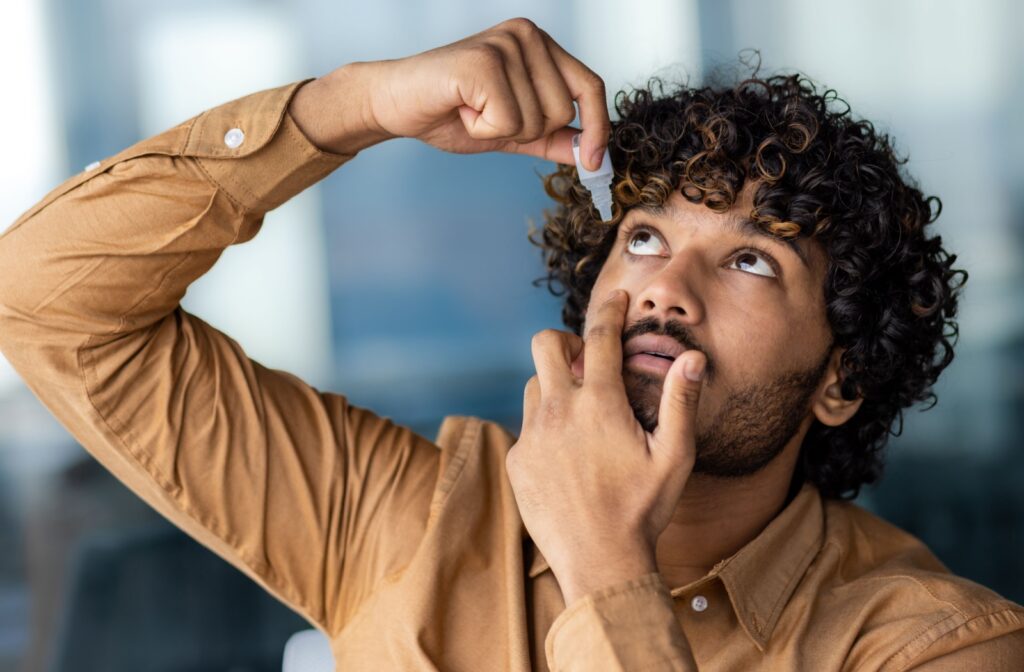Eye strain, also known as asthenopia, is a common issue that can develop after prolonged or intense use of the eyes. It often occurs when people spend long hours reading, driving, or focusing on digital screens. With the growing reliance on computers and smartphones, digital eye strain has become a widespread concern.
Many people experience symptoms like blurred vision, sore or tired eyes, headaches, and difficulty focusing. The effects of eye strain vary depending on a range of factors, including the duration of eye strain and whether you have underlying vision conditions. In some cases, the symptoms fade quickly. In others, they may linger into the next day or become chronic without lifestyle adjustments or treatment.
What Causes Eye Strain to Linger?
Several factors affect the duration of eye strain symptoms. While the discomfort may feel similar from one day to the next, the underlying triggers can differ.
Digital Device Use
Staring at screens for hours is one of the most common causes of eye strain. Digital eye strain occurs when your eyes work harder to focus on pixelated text, especially at close distances. You may blink less frequently while using screens, which can cause the surface of your eyes to dry out and exacerbate discomfort. Blue light exposure may also play a role in visual fatigue, although evidence is mixed on whether blue light itself is a significant cause.
Task Duration & Intensity
Spending a few minutes on a screen or reading a book may cause minor strain, but extended tasks, such as a full workday in front of a computer, can lead to symptoms that last much longer.
Existing Eye Conditions
Undiagnosed refractive errors such as astigmatism or hyperopia can contribute to ongoing discomfort. People with dry eye disease or uncorrected vision prescriptions may experience longer or more frequent episodes of strain.
Lighting & Environment
Bright lighting, glare from windows, or dry indoor air can intensify symptoms. Sitting too close to your screen or holding a phone too near your face can also contribute to fatigue.
Break Patterns & Habits
The longer your eyes work without a break, the more likely it is for strain to build up. Skipping breaks or ignoring the early signs of tiredness can prolong the time it takes for your eyes to feel normal again.
How Long Do Symptoms Typically Last?
The duration of eye strain can range from minutes to days, depending on the cause and how quickly it’s addressed. Here’s a general guideline:
- Mild digital eye strain: Often fades within 15 to 30 minutes of taking a break and resting the eyes.
- Moderate or prolonged strain: Symptoms may linger for several hours, particularly after a full day of computer or phone use.
- Chronic strain or untreated causes: Discomfort can persist daily and may not fully go away until contributing issues, like screen use habits or vision prescriptions, are addressed.
What Helps Relieve Eye Strain?
While rest is essential, other steps can help speed up recovery and reduce future symptoms, especially for those working with screens daily.
Eyezen™ lenses by Essilor
Eyezen™ lenses by Essilor are designed specifically for how we use our eyes today: frequent screen time, small print, and prolonged focus. These lenses offer subtle magnification in the lower portion to support near-vision tasks and help reduce eye fatigue. They also include advanced light filtering to cut glare and enhance contrast, making screen use more comfortable without relying solely on blue light protection.
Neurolens®
Another option worth exploring is Neurolens®, which takes a different approach by addressing eye misalignment, an often-overlooked contributor to symptoms like headaches, eye strain, and neck stiffness. By incorporating a contoured prism that adjusts across distance and near zones, Neurolens helps realign how your eyes work together, reducing the demand on your visual system. For people with persistent digital eye strain despite wearing standard glasses, Neurolens can offer a significant improvement in day-to-day comfort.
Try the 20-20-20 Rule
Every 20 minutes, look at something 20 feet away for 20 seconds. The break allows the focusing muscles in your eyes to rest.
Adjust Your Screen
Make sure your screen is at eye level or just below, about an arm’s length away. Text should be large enough to read comfortably without squinting.
Reduce Glare & Improve Lighting
Use blinds or curtains to reduce glare from sunlight. Position your screen so light doesn’t reflect off the surface. Soft, diffused lighting can reduce eye strain.
Blink More Often
Digital screen use can reduce blink rate, leading to dryness. Consciously blinking more frequently helps rehydrate the eyes and refresh your vision.
Use Artificial Tears
If your eyes feel dry, lubricating drops can provide relief. Preservative-free formulas are typically gentler for regular use.
Hydrate & Consider a Humidifier
Dry indoor air can worsen digital eye strain. Staying hydrated and using a humidifier can help maintain a healthy tear film.
Update Your Prescription
Ensure your glasses or contact lens prescription is up to date. Some people may benefit from computer-specific eyewear, which can reduce strain during screen use.

When Symptoms Don’t Go Away
Occasional eye strain is common and usually temporary; however, symptoms that persist may indicate underlying issues.
It’s a good idea to speak with an optometrist if:
- You experience discomfort daily, even after resting your eyes
- Symptoms last longer than 24 hours after a visual task
- You’ve already made changes to your environment or habits without relief
An eye exam can help identify the root causes of strain. Conditions such as dry eye, convergence insufficiency (eye teaming issues), or meibomian gland dysfunction may be contributing factors. Treatment options might include lubricating drops, specialty eyewear, in-office therapies, or targeted lifestyle adjustments.
Managing Chronic Digital Eye Strain
For people who spend hours each day in front of screens, preventing and managing digital eye strain is often an ongoing process. Simple habits, like taking regular breaks, improving lighting, and blinking more often, can go a long way. However, if symptoms persist, it may be time to explore potential causes and seek professional solutions, including:
- Updating your prescription
- Using artificial tears as needed
- Following an ergonomic workstation setup
- Wearing task-specific eyewear if recommended
Why Vision Veritas?
Digital eye strain may not resolve on its own without some form of adjustment. If you’re struggling with eye strain, visit us at Vision Veritas; our team is ready to help you with your eye care journey. Discover the veritas (“truth” in Latin) behind exceptional service and patient care with our family-owned and operated team at Vision Veritas. We look forward to serving you.





